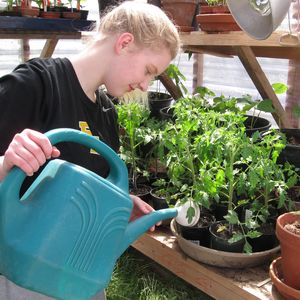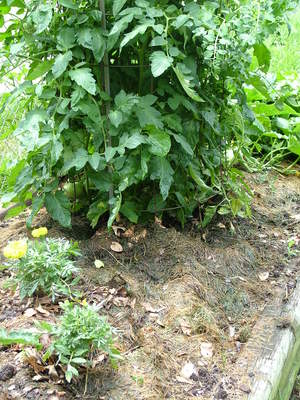Are you new to vegetable gardening this year? You’ll soon discover that it takes more than sunshine, water, and loamy soil to grow a productive vegetable garden. As your vegetable plants grow and temperatures heat up, your garden will need extra attention to keep it vibrant and healthy. Here are 8 common problems that can be fixed with a little “first aid”.
Leaf wilt. I live in the high desert where our arid climate will dry out the soil in a matter of a few hours, causing plants to wilt. Adding mulch such as grass clippings, straw, or even several layers of newspaper covered with sawdust helps reduce ground water evaporation and keep weeds in check too. Over watering can also cause plants to wilt. I water when the soil is dry to a depth of 2-3 inches and water deeply using channel irrigation.
Rot and mildew. If your vegetables and plant leaves are sprawled over the ground and suffer from rot and mildew, careful staking will generally solve this problem. Staking saves space and brings leaves up into the air which improves circulation and lets light reach into the depths of the plant. Plants are best staked after planting so as to avoid damaging developing roots.
Pest infestation. Chomp bites, curled leaves, and holes in the vegetables are signs of a pest infestation. I turn my chickens into the veggie garden at least once a week to manage garden pests; if this isn’t an option for you, regular application of an environmental friendly pesticide is a great alternative. So that you purchase the right kind of pesticide, bring a sample of the damaged leaf or vegetable (or even the pest itself) to your favorite garden shop for identification.
Scorched leaves. Overhead watering can cause scorch marks on the leaves of your plants. If your plants are peaked and need some after watering, give them a good watering at the roots instead. No soaker hose? A one gallon milk jug with a couple of nail holes punched through the base and then filled with water is a great alternative.
No zip. Halfway through the summer growing season, the vegetable plants will have used up most of the available nutrition in the soil. This nutrition can be replaced with a good all purpose fertilizer which can be troweled around the roots or applied alongside the furrows.
All growth and no fruit. If your plants are all leaves and no vegetable, too much of the plant’s energy is going towards vertical growth. We regularly pinch back growth buds, flowers, and immature vegetables which results in a better yield and larger produce.
Spindly. Vegetable plants require a certain amount of space and sunshine to grow and packing them too closely results in a poorly developed plant. Vegetable plants should be thinned to the proper distance as recommended on the seed packet.
Overtaken by weeds. Weeds aren’t just unsightly to look at, they will rob your vegetables of water, nutrition, and root space. It’s best to weed while the weeds are still young to avoid damaging the roots of your vegetable plants. We discovered that regular weeding boosts the health of a veggie crop and prevent weed seeds from spreading throughout the entire bed.
More by this contributor:
How to speed up seed germination.
How to create more growing space in your vegetable garden.
Eight high yield vegetables worth growing in your garden





